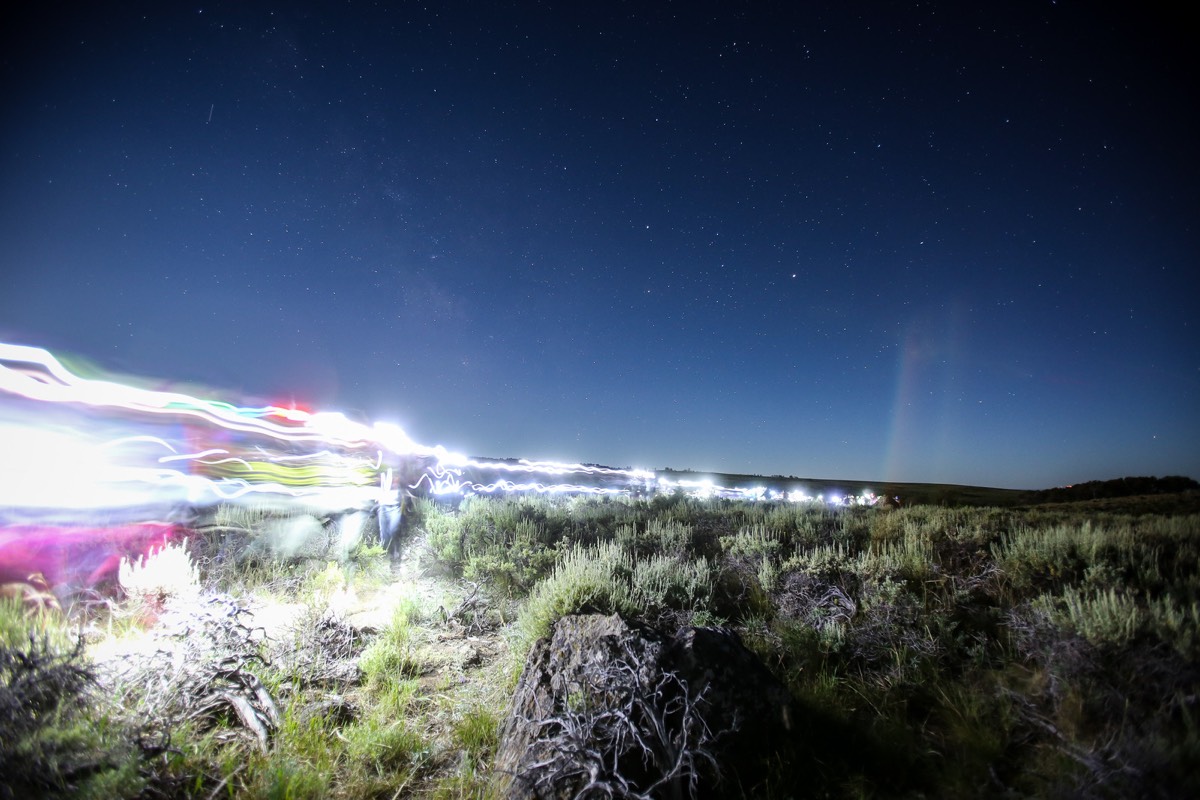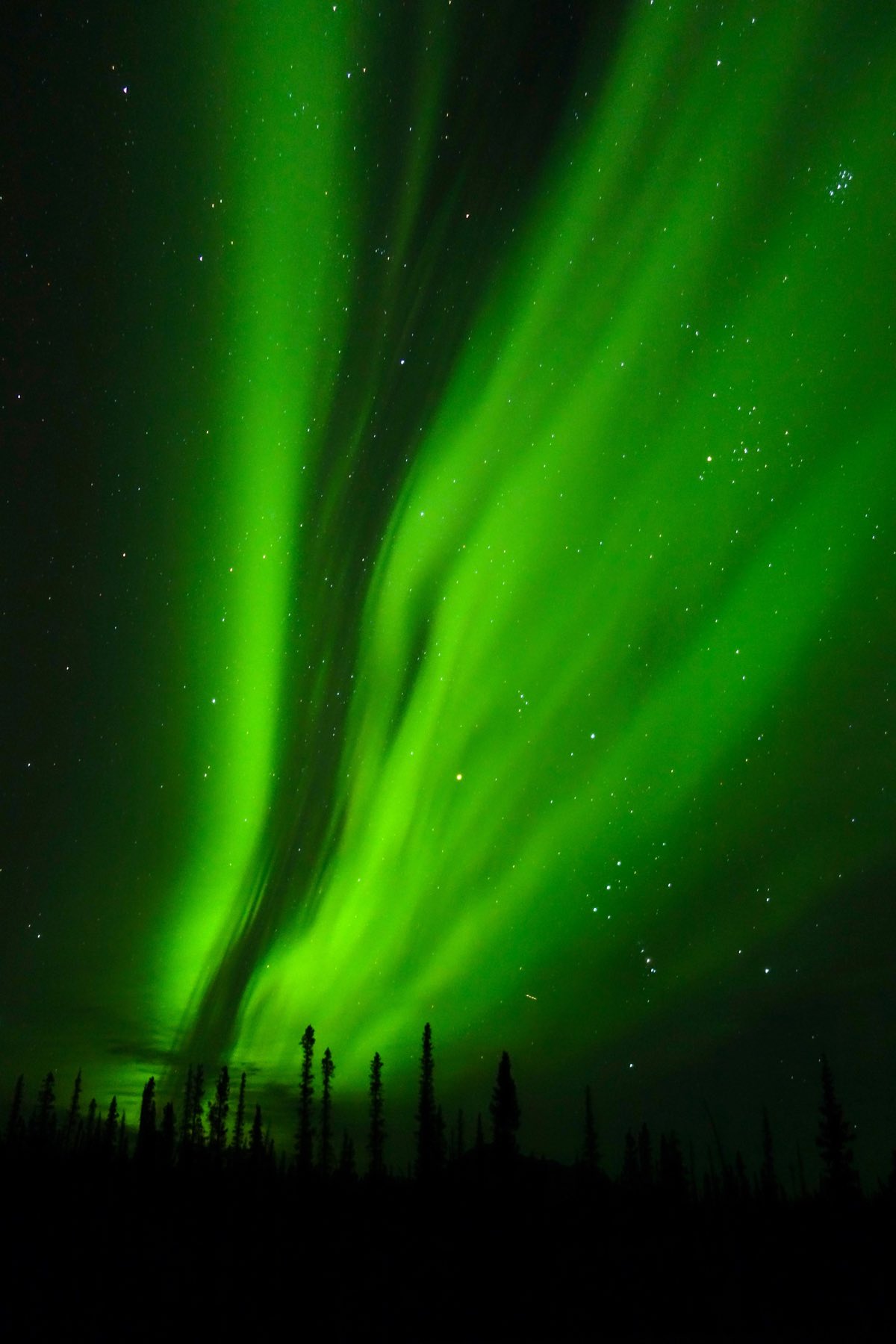My first experience running through the night was at the 100-plus-mile UTMB in the European Alps. I’d been running and hiking in the dark since I was a young kid, but never all night long. UTMB starts a few hours before sunset, which gives each runner the opportunity to spend at least one full night out on the course. Many runners spend two.
For me in 2015, the moon was bright, my energy was high, and the first four hours were a magical experience. But then, as the adrenaline of the early race wore off and sleepiness set in, I had to physically take off my headlamp and shine it in my eyes to stay awake. (I don’t recommend this.) I also slammed caffeine at every aid station and poured water on my face to keep my eyes open. I’m not a jealous person generally, but I was intensely jealous as I looked down from high on the mountain to the quiet villages below, knowing people were asleep in their warm beds down there.
Watching the sun set and knowing you will still be running when it rises again the next day is an exciting, freeing, albeit slightly frightening experience. While running all night might be an unusual occurrence for most of us, fitting in a pre-dawn run before work or hitting the trails in the evening are–or could be–regular occurrences for many trail runners. And doing so can be a lot of fun!
This article should shed some light–I’m so sorry for that–on running in the dark, and help you prepare to stretch your comfort zone. As with anything, education and preparation are fuel for your confidence. If you prepare reasonably and think logically, you will greatly increase your comfort with running in the dark regardless of if you are running a few miles before work or all night long during a big adventure.

Nighttime trail running can be a great adventure and a way to get the miles in around the rest of your life. Photo: Kevin Jantzer/Steens Mountain Running Camp
Lighting
If you are ever running on trails at dusk, night, or dawn, extra light is pretty much imperative. There are three basic options: a headlamp, waist lamp, and a hand-held light. While most runners use a headlamp, a combination of two of the three can be helpful depending on the terrain and your comfort level.
Lighting technology has really progressed in the past five years and there are a variety of headlamps under $100 that provide 300 or more lumens. What’s a lumen? A lumen describes the measure of quantity of light emitted from your light source, specifically the measure of one candle from one foot away. In essence, just know is that more lumens equals more light and 300 of them is plenty for comfortable night trail running.
Headlamps today feature USB rechargeable batteries, are lightweight, use bounce-free designs, and have adjustable brightness levels. Reviewing some headlamp options and purchasing one that fits your needs is a must before heading out onto dark trails. If you want a secondary light, a hand-held light or headlamp looped around your waist can be helpful to aid with additional visibility and depth perception.
Here are some factors to consider when choosing a headlamp:
- Weight – A lighter headlamp may mean it has less battery life or fewer lumens, but it may also bounce less or feel more comfortable.
- Lumens – I hate giving a minimum because my one-ounce, 50-lumen Petzl E+lite has gotten me off the trails more than once when I overshot sunset, but for comfortable trail running I would look for a light with 300 lumens or more.
- Battery life – This depends on how long you intend to use it and at what power. Are you running all night or is this more of a light to use when hitting the trails early before work?
- Adaptive lighting – Do you want your light to adjust based on your line of sight? This means it will get dimmer when you’re looking at something close up and brighter when you’re looking into the distance.
- Battery rechargeability – I love the ease of recharging my headlamp via USB and not having to dig around to find batteries every few weeks.
- Comfort – This thing is going to be strapped to your head as you run, so trying a few on at your local running shop to see what feels nice is a great idea.
If you’re looking for specific headlamp ideas, check out this list of recommended headlamps for all-night running by the Trail Sisters.
Don’t Fall
The most likely misfortunes of running at night are generally pretty mundane. Tripping on a root or getting colder than expected don’t incite worry and terror like seeing a pair of eyes staring back from the darkness or realizing you have taken a wrong fork in the trail and gone a bit out of your way. But the mundane is far more likely to occur. Tripping, smashing a toe, taking a tumble, or twisting an ankle are all risks that can be diminished with good lighting and occasional cadence or stride adjustment. When a trail transitions from buttery smooth to rocky and rooty, you naturally adapt your stride to fit the terrain. You’ll want to do the same at night, when your vision is a bit impaired. Also consider picking up your feet a little more than normal to avoid tripping on unseen obstacles. Slowing down a bit is so much better than falling.
Clothes and Gear for the Night
When dressing for a run that’s early in the morning, late at night, or goes all night long, versatility is your goal. Temperature fluxuations are significant when the sun drops and when it again rises. In some geographic locations, like deserts, these can be fluctuations of 40 degrees Fahrenheit in a few hours. I’ve never been as cold as when the sun set following a hot day on the trail. Think layers. Clothing that can be easily donned at dark and then shed with the dawn is ideal. Packing an extra thermal layer or a hat and gloves is always wise when heading out for a run in the dark.
If you’re only going to be out for a couple hours, you may not need many snacks. However, when running at night it’s always wise to bring a couple more snacks than you think you’ll use, just like carrying an extra clothing layer. Lastly, consider caffeine. When it is dark out my brain thinks it’s time to sleep, and staying alert can be difficult. Packing a few caffeine gels or some caffeine trail butter is a must. You may not always feel the need to use it, but again, the fact that you have it provides a little bit of preparation-fueled confidence.

An example of what the author might take on a short night run, including a headlamp, a back-up headlamp, a phone, snacks, and an extra layer. Photo: David Laney
General Safety
One naturally feels a bit of fear or anxiety about doing something new, especially running through the woods at night. Generally, I do not consider running at night to be unsafe but, when something minor does go wrong, it may have greater consequence at night. It takes longer to move through the woods at night, the temperatures are usually colder, and it’s easy to miss a turn or be startled by an opossum out for her midnight stroll. Should something go wrong, being prepared will right the wrong more quickly. Also, knowing you’re prepared for contingencies can offer a sense of comfort and confidence.
Here are some more thoughts on safety for running at night.
- Take a friend – Running with someone else obviously allows for another level of safety at night. I’ve found most friends will be willing to run at a heinous hour if coerced with coffee and cookies. Four-legged friends usually don’t protest a dawn-patrol stroll, and are often better conversationalists anyway. Check your local running shop for a group to join or to find a buddy with a similar schedule. Sometimes just having someone else there will give you the confidence to hit the dark trails.
- Let others know – Always let a friend know exactly where you are starting from and when you plan to return. This is equally applicable to running at night or during the day.
- Protect yourself – Carrying a self-defense tool and being comfortable using it if needed will go along way in feeling and being safe, especially in the dark. When running on trails in Alaska, I typically carry bear spray. I’ve never reached for it, but it puts my mind at ease when I can’t see more than a few feet ahead of me through thick alder groves.
- Be visible – While you may not be worried about traffic on your trails, being visible and letting others know you’re out there with plenty of time for them to give you space is smart. Often our runs are not exclusively on trails either, as we may cross roads or run roads en route to the trailhead. Drivers don’t expect runners out in the dark. Be obvious.
- No headphones – Headphones block out noises from traffic, other trail users, wildlife, and anything else you may need to notice. If you just have to listen to the latest trail running podcast, use only one earbud.
- Be aware – The most likely tragedy of running at night is getting back to the trailhead to find your car window smashed and your nano-puff jacket stolen. Is there glass on the ground at the trailhead? Don’t leave valuables in your car–or at least hide them. Pay attention! Is a storm coming? Is the temperature going to drop a bunch when the sun sets? Are you more likely to trip on a root at night and twist an ankle? Identify potential risks and then plan for them.
- Carry a phone but don’t rely on it – You might not have cell service, but you might! You can also choose to do your early morning or late-night runs in an area where you have reliable service. Carrying a phone is one way to help resolve an issue if you get lost, really twist an ankle, or suddenly find yourself a wee bit turned around. But it’s just a phone! In an emergency you can’t eat it, it can’t keep you warm, and it won’t splint a leg. Without service and battery the phone is useless, so don’t let the phone give you unreasonable confidence without proper gear and preparation.
Final Thoughts
When the sun finally rose during the 2015 UTMB, I rolled over the high pass of Grand Col Ferret and crossed the border from Italy to Switzerland to begin the daytime part of my race. I was totally reenergized. My desire to sleep melted away instantly and life literally went from dark to light.
Watching the sun rise after a long night of running, or even on any morning, is an inspirational sight and a phenomenal way to start the day. Prepare, be confident, and then enjoy the wild side of hitting the trails at night!
Call for Comments (from Meghan)
- What’s in your pack on a night run lasting two hours or less? How about a longer night run?
- What general safety tips do you have or use so that you feel comfortable and confident while you’re running at night?

